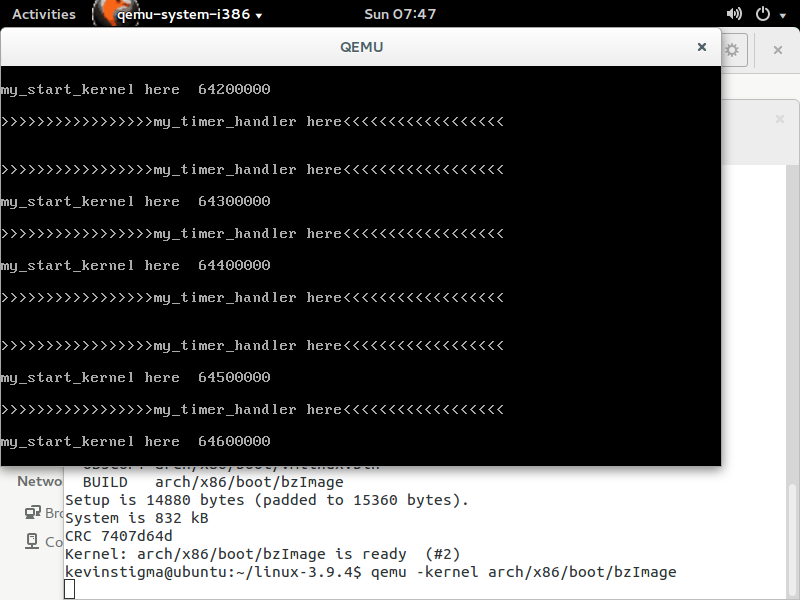朱宇轲 + 原创作品转载请注明出处 + 《Linux内核分析》MOOC课程http://mooc.study.163.com/course/USTC-1000029000
本次课程老师为我们演示了一个简单时间片轮转多道程序内核代码,今天我们讲对它进行运行和分析。
实验截图
需要到github上下载mykernel的源代码并加载到Linux系统中。这里需要注意自己的Linux版本,我之前用的是CentOS,不能执行老师提供的命令,重装了ubuntu之后才终于解决了问题,神坑无比TAT

配置完环境后运行效果如下:

实验分析
这个mykernel内核实际上重点就是三个文件:mypcb.h、mymain.c和myinterrupt.c。它们各有不同的功能,mypcb.h定义了进程管理结构PCB和Thread,mymain.c定义了各个进程的PCB并初始化进程,myinterrupt.c定义了进程主动调度及时钟中断处理。
首先是mypcb.h文件
#define MAX_TASK_NUM 4
#define KERNEL_STACK_SIZE 1024*8
/* CPU-specific state of this task */
struct Thread {
unsigned long ip;
unsigned long sp;
};
typedef struct PCB{
int pid;
volatile long state; /* -1 unrunnable, 0 runnable, >0 stopped */
char stack[KERNEL_STACK_SIZE];
/* CPU-specific state of this task */
struct Thread thread;
unsigned long task_entry;
struct PCB *next;
}tPCB;
void my_schedule(void);
PCB定义了每个进程的组织结构,其中pid表示进程号,state代表进程状态,stack为进程的内存空间,thread.sp为进程内置的栈顶指针,thread.ip为进程当前指向的代码。注意next指针,它指向当前的下一个进程,实际上是使该进程组在内存中组织为一个循环链表。

然后是mymain.c文件
#include <linux/types.h>
#include <linux/string.h>
#include <linux/ctype.h>
#include <linux/tty.h>
#include <linux/vmalloc.h>
#include "mypcb.h"
tPCB task[MAX_TASK_NUM];
tPCB * my_current_task = NULL;
volatile int my_need_sched = 0;
void my_process(void);
void __init my_start_kernel(void)
{
int pid = 0;
int i;
/* Initialize process 0*/
task[pid].pid = pid;
task[pid].state = 0;/* -1 unrunnable, 0 runnable, >0 stopped */
task[pid].task_entry = task[pid].thread.ip = (unsigned long)my_process;
task[pid].thread.sp = (unsigned long)&task[pid].stack[KERNEL_STACK_SIZE-1];
task[pid].next = &task[pid];
/*fork more process */
for(i=1;i<MAX_TASK_NUM;i++)
{
memcpy(&task[i],&task[0],sizeof(tPCB));
task[i].pid = i;
task[i].state = -1;
task[i].thread.sp = (unsigned long)&task[i].stack[KERNEL_STACK_SIZE-1];
task[i].next = task[i-1].next;
task[i-1].next = &task[i];
}
/* start process 0 by task[0] */
pid = 0;
my_current_task = &task[pid];
asm volatile(
"movl %1,%%esp
" /* set task[pid].thread.sp to esp */
"pushl %1
" /* push ebp */
"pushl %0
" /* push task[pid].thread.ip */
"ret
" /* pop task[pid].thread.ip to eip */
"popl %%ebp
"
:
: "c" (task[pid].thread.ip),"d" (task[pid].thread.sp) /* input c or d mean %ecx/%edx*/
);
}
void my_process(void)
{
int i = 0;
while(1)
{
i++;
if(i%10000000 == 0)
{
printk(KERN_NOTICE "this is process %d -
",my_current_task->pid);
if(my_need_sched == 1)
{
my_need_sched = 0;
my_schedule();
}
printk(KERN_NOTICE "this is process %d +
",my_current_task->pid);
}
}
}
该文件的my_start_kernel函数首先初始化了每一个进程,然后执行汇编部分,前两句话目的是将ebp和esp都指向0号进程PCB中的栈底。3,4句则是跳转至进程0的起始地址。
至于my_process函数,则就是每个进程的执行函数。当my_need_sched==1时,进入中断切换到下一个进程。
myinterrupt.c的代码如下
#include <linux/types.h>
#include <linux/string.h>
#include <linux/ctype.h>
#include <linux/tty.h>
#include <linux/vmalloc.h>
#include "mypcb.h"
extern tPCB task[MAX_TASK_NUM];
extern tPCB * my_current_task;
extern volatile int my_need_sched;
volatile int time_count = 0;
/*
* Called by timer interrupt.
* it runs in the name of current running process,
* so it use kernel stack of current running process
*/
void my_timer_handler(void)
{
#if 1
if(time_count%1000 == 0 && my_need_sched != 1)
{
printk(KERN_NOTICE ">>>my_timer_handler here<<<
");
my_need_sched = 1;
}
time_count ++ ;
#endif
return;
}
void my_schedule(void)
{
tPCB * next;
tPCB * prev;
if(my_current_task == NULL
|| my_current_task->next == NULL)
{
return;
}
printk(KERN_NOTICE ">>>my_schedule<<<
");
/* schedule */
next = my_current_task->next;
prev = my_current_task;
if(next->state == 0)/* -1 unrunnable, 0 runnable, >0 stopped */
{
/* switch to next process */
asm volatile(
"pushl %%ebp
" /* save ebp */
"movl %%esp,%0
" /* save esp */
"movl %2,%%esp
" /* restore esp */
"movl $1f,%1
" /* save eip */
"pushl %3
"
"ret
" /* restore eip */
"1: " /* next process start here */
"popl %%ebp
"
: "=m" (prev->thread.sp),"=m" (prev->thread.ip)
: "m" (next->thread.sp),"m" (next->thread.ip)
);
my_current_task = next;
printk(KERN_NOTICE ">>>switch %d to %d<<<
",prev->pid,next->pid);
}
else
{
next->state = 0;
my_current_task = next;
printk(KERN_NOTICE ">>>switch %d to %d<<<
",prev->pid,next->pid);
/* switch to new process */
asm volatile(
"pushl %%ebp
" /* save ebp */
"movl %%esp,%0
" /* save esp */
"movl %2,%%esp
" /* restore esp */
"movl %2,%%ebp
" /* restore ebp */
"movl $1f,%1
" /* save eip */
"pushl %3
"
"ret
" /* restore eip */
: "=m" (prev->thread.sp),"=m" (prev->thread.ip)
: "m" (next->thread.sp),"m" (next->thread.ip)
);
}
return;
}
my_timer_handler应该是一个系统内部运行的累加程序, 用来控制my_need_sched的值,从而来判断是否需要切换进程。
my_schedule则是进行进程切换的主要函数。首先需要判断当前进程是否为空,若否,则进入汇编模块。在汇编模块中,分别存储当前进程的ip、sp等信息,将要执行进程的sp赋给esp,并将它的ip入栈并赋给eip(ret操作),然后系统就会去进入下一个进程的代码空间,执行该进程。需要注意的是,汇编代码中“movl $1f,%1 ”这一段是将当前进程目前执行的代码处存储到sp中,当下一次进程调度轮到它时就会直接执行上次执行到的下一行代码。$1表示一个标号,也就是汇编代码段中“1: ”处,下次再调度到该进程时就会从那里开始执行。
由于待执行的进程状态的不同,my_schedule函数分出了if和else两段代码,其实大同小异,大家可以自己再进一步理解一下其中的差异。
本次课程的代码就分析到这里,谢谢大家!